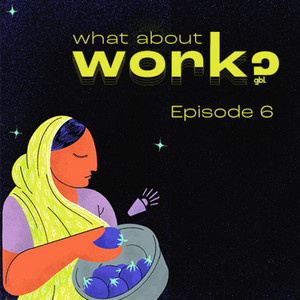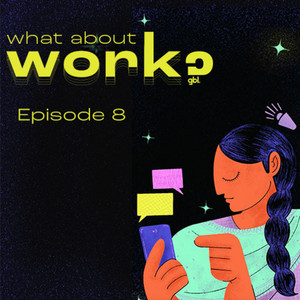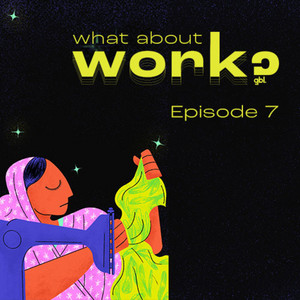The fifth episode of What about work? Gathers diverse perspectives on the ways to tackle women workers’ limited access to financial resources. Can the private sector support low-income women workers in maximizing their income?
We consider one possible intervention, a salary advance tool by Good Business Lab that enables workers to have fast and flexible access to incomes at their workplace. However, with gendered differences in technological knowledge, a Digital Financial Service (DFS) tool comes with many challenges. Hence, focusing on a training course which emphasizes both awareness and practical usage of the tool.
Tune in to hear more from the women workers, find out more about the tool, and the challenges and the benefits that come with it.
Transcript
Anant N: We found that amongst a focus group of workers, nearly half of them said they often are always worried about being able to manage monthly expenses or find themselves waiting for the next paycheck at the end of their pay cycle. Roughly like 15- 20% of them said their households had to cut down on medical expenses or doctor visits even during acute illness. And about a third of them report worrying about financial matters interferes with their daily routine. That could be their sleep, you know, critical things that they need for their own wellness.
Hello! And welcome to What about work? An audio series produced by Good Business Lab.
Good Business Lab seeks to globally transform the lives of low-income workers through rigorous research and evidence-based solutions.
What about work? talks about the past and current experiences of workers in labor-intensive industries and other emerging sectors across geographies. Be it garment, automobile, fast food, platform gig work or any other.
The last episode discussed what financial obstacles low income women workers in India experience.
As Good Business Lab’s Field Analyst Shaila tells us, there are very real and complicated problems that women workers experience due to low access to financial resources and little support from those around them. This becomes increasingly difficult when women are often not allowed to share their opinions about how money gets spent.
Shaila M: Some women are married and not divorced but their husbands don’t take responsibility. So, the women have to take care of everything. Some other workers come for work and give their salaries to their husbands and mother in law. They are not involved in the decision making. However, they would like to be. One worker’s mother was unwell. She called up her relatives for financial assistance but no one picked up her call. Somehow, she was able to manage. She used to walk to the hospital everyday for 6km, attend to her mother and then come for work. One worker’s husband sold the house without informing anyone. Now they are living in a rented place.
Even when women sacrifice their own needs for their families’ sake, they still struggle financially. How can the private sector deal with the difficulty low-income families experience in stretching their earnings? Today’s episode will look at exactly this.
Here’s co-founder and Chief Strategy Officer of Good Business Lab, Anant Nyshadham sharing one possible solution.
Anant N: What we’ve developed is this kind of salary advance or pay on demand tool.
Because it’s just between the last paycheck and the next paycheck.
A flexible salary advance tool offered at the workplace enables workers to have access to their incomes when they are facing a cash crunch. While this secures workers across the board, it’s especially important for women. The United Nations Program for HIV/AIDS stated in a 2012 report that women and girls were more vulnerable to economic shocks.
Labor-intensive industries can institute mechanisms that support women workers during these periods of crises.
Anant N: In times of emergency, instead of waiting until the end of the month They can withdraw these small amounts without having to either wait and delay, maybe important expenses like even just food or medical bills or school fees. And also certainly to put access points where they are on the factory floor, have these kinds of tabs that will allow you to use this tool right there.
Many workplaces do have protocols in place that allow workers to take an advance on their salaries. But as Field Associate at Good Business Lab Sneha points out,
Sneha P: In fact, there was a lot of conversation from the factory site saying that very less like 3 to 4% of people in like one or two years have taken this. because, you know, it takes a lot of time. It is a long procedure. That is why one thing and the second thing is also that you know, it’s a long procedure, it’s not immediate I mean like you know, they cannot apply in the first week of the month because that’s when the salary get processed and after they apply, they have to wait, I think for 7 to 10 days minimum in order to get this money.So for, for those people who are in need of emergency, they’ll have to wait another 10 days. So what they do instead of waiting, is go to a money lender and get it.So that is actually the very huge difference between the sort of salary advance that we talk about and the sort of salary advance in that unit.
Having almost immediate, flexible access to your own salary at a time of need can have a big impact on your personal and professional wellbeing. In a study carried out by Good Business Lab in collaboration with Busara Center of Behavioural Economics, we found that some women factory workers were so entrenched in debt that 50% of their expenses went into repayments. Withdrawing from your own salary could then assist people in the typical waiting periods between paycheck to paycheck. This could reduce the stress a person in debt feels. It could also help bolster a worker’s trust in the firm they work in as a meaningful network of support.
Deborah Charles, Research Associate at Good Business Lab, frames it like this.
Deborah C: I think an important aspect that we’re also trying to convey through this is that you are telling workers that although they have their own means of getting money or informal borrowing, through a money lender or chit funds or from family or friends or whatever. This is one more option that they have that they can use to get money immediately when they need it. From their own salary. That’s what we want to emphasize. you’re not stuck in this vicious cycle to borrow money, but Use your own salary for your own self-reliance.
But the use of this tool is dependent on how well workers can actually use it. Especially in a context where women have had low access to digital technology.
We know that only around 2.5% of women in India have access to digital financial services also known as DFS. So how can these access and knowledge gaps be reduced? Good Business Lab’s Research Manager Simranjeet says that Good Business Lab and IDinsight along with a prominent garment exporter,
Simranjeet D: Conducted an experiment with migrant female garment workers where we did design like a training program to increase the uptake of A D F S service by lowering the knowledge barrier. And although this was very intuitive and it did provide us a lot of understanding into this space, we did see limited success in terms of increasing the usage. So there is an aspect of providing awareness and then there’s an aspect of that usage.
It’s not enough to be aware of services. A study carried out by researchers in collaboration with a gig economy platform in Bangladesh found that while 83% of the women in their sample were aware about basic digital financial services, less than 5% actually deposited money using these means. There has to be active intervention by firms to not only place tools at points most convenient for workers, but also to continuously train workers on the usage of these tools.
Active training is vital to ensuring that workers receive the full benefits of tools that offer things like flexible salary advances.
Deborah dove into the nitty grittys of designing training modules that meet workers where they are. What visual considerations should be made? How do workers think about money itself? What all goes into building a fair and valuable training program?
Deborah C: One more thing that was important is that this was a learning from visiting factories one of the HR teams was telling us that, it’ll be nice if whatever you’re delivering to us would be bright and colorful and catchy. So that’s also something that we wanted to incorporate. <> So if you look at the models, it’s like a really bright red color and also a little bit of a clashing blue and using, like, fun characters so that the attention is grabbed in a way that necessarily doesn’t rely on interactivity. Because there are so many limitations from the factory set up right workers, have a limited amount of time that they can come and engage in training and usually, they have production pressure. Even if we kind of succeed in bringing them to the training. Is that mind really in the training, or are they sitting and thinking about, like, Oh, I have to go back and complete XYZ pieces. This would be scarier because they’re like okay what if my salary gets messed up with what if it doesn’t get accounted properly, What if I use this application or tech tool and then there’s some discrepancy in like the way my money comes, the next month. So all of these apprehensions were something that we considered as well.
Often, new technological interventions fail to make a direct connection with vulnerable people. It is crucial then to speak to workers and contextualize digital tools in their lived experiences.
Deborah C: I wish I could show you honestly, but for example, when we’re taking them through the narrative of not being able to have enough money to go back home because a mom is sick then having this visual of a bus leaving and the money flying behind the bus. Because for them, to take that bus journey, going back home means that it’s a cost of losing out on money. Whether in terms of earning hours or money being spent.
The site of the training can be a way to show workers all of this and more. Simranjeet adds,
Simranjeet D: So we, we basically provide them an extensive training where they’re able to access the tool, understand how to use it, understand what happens in case they have an issue, how does the redress still take place? We have done extensive amounts of qualitative rounds both in urban and rural settings and have made a conscious decision on what information they would actually need. The elements of trust, the elements of ease of use.
Deborah C : Honestly training is I think best delivered when it’s if you kind of use it in a variable format, but also your consistently delivering it to them, for example, if I deliver it right now but then I come back in, a few weeks and reinforce the same concepts again, it’s a nice, touch point for workers. There might be early adopters and they start using it, but there’ll definitely be people who are a little weary of it. For instance, if you can’t go and consistently speak to the workers and periods of intervals can make workers a little wary. So, in that training, you also reassured them that, Hey, don’t worry. If something goes wrong, there’s this number that you can call and tell us, or there is someone who will be next to the tablet and who’ll help you use it. If you’re confused at any point or if there’s any concern you can always go to the admin room and we’ll help you sort it out. So you’re also providing them reassurances when you’re showing them that this is a new tech tool.
Constant and consistent communication with workers is key to introducing useful interventions in factory settings. Especially when the conversation is about money. In many social contexts, there are taboos against speaking about financial matters.
Bringing workers in a room to train them on how to use a tool also offers a way to break such taboos. Openly discussing problems and solutions could potentially be highly effective in encouraging everyone, particularly women, to learn more about managing money. Trainings can also serve as a conduit between workers who have strong advice and workers who need it.
But there are limitations to tools like these. Other factors such as last-mile connectivity of banks are also critical components of ensuring comprehensive support to women workers. Connectivity can mean physical access. But it can also mean navigating specific problems that arise by having to access it at a particular time of need.
Here’s Anant and Apoorv with more.
Anant N: You might in theory have a bank account, you might have a bank nearby, but that doesn’t mean that you’re an active user of the account. And so there’s a lot of this kind of functional literacy that has to be thought about as well. Do you have a level of comfort with accessing banking resources? That means that when in need, you will turn to those resources. That’s where I think we see a pretty large divide here in the South Asian context between men and women.They just don’t traditionally have experience in interacting with the formal financial sector.
Apoorv S: Some of the women said that they do not access the ATM themselves. It could be their son, it could be their husband, it could be anyone else. So in this case, I think the bigger question becomes that they would become more reliant on someone else to take out their salary. and then that totally depends on household dynamics and whether the household dynamic allows them to do that. Secondly, the other thing that could be a question mark is the fact that if they rely on their spouse to withdraw money from the bank account, then this whole aspect of disclosure goes out the window because they do have to disclose the fact that they have taken out their earned salary.
If you have to take an advance on your salary due to, say, a pending loan you did not inform your spouse of for various reasons, then it’s difficult to justify to them why you are withdrawing a portion of your salary on a random day. Things like this require structural transformations of degrees that rest outside the scope of technological interventions.
But not solving everything doesn’t mean nothing is being solved.
Anant N: this is a tool that would allow you to kind of address unexpected lumpy expenses when they come up, not be prone to these negative effects of informal lending and then the effects of the financial stress. your cognitive functioning, maybe your earning potential, your productivity or your attendance at work and so on.and we got, you know, response is like that from our qualitative studies or focus groups when we were kind of developing this where women said, ok, I, I won’t need to ask anyone for the money rather I can just take it from my own salary. and, I’ll be able to meet emergencies.
The private sector can play a vital role in addressing and alleviating challenges women come up against. Feeling like your problems are being heard can be a big deal for them. To know that their employer understands them. To feel that their wellbeing is prioritized. Easing financial stress is a powerful part of worker wellbeing.
Thank you for listening to What about work?. That was our deep-dive into women workers’ financial problems and the impacts that private players can make in addressing them.
We will be back after a short mid-season break! Get ready to hear about alternative supply chains and the value of worker voice. About wellbeing and those embedded in the research and experience of it in future episodes
We always welcome constructive feedback. Have anything you want to say? Drop us a message @goodbusinesslab on Twitter, Instagram, or LinkedIn. You can also visit our website goodbusinesslab.org to learn more about our approach to worker wellbeing.




